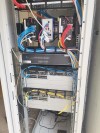
Some definitions of microgrids
“The microgrid is an aggregation of micro loads and generators operating as a single system capable of providing both thermal and electrical demands.”
“The microgrid is a low voltage network, where they are present generation unit that storages, as well as loads. It can operate in a non-independent, if connected to the main network, or stand-alone mode, if disconnected. ”
“The microgrid is a service system of the proposed core network to manage and integrate into the network of the various micro-generation units.”
Microgrid is a Medium / Low voltage network, composed of production units, different by size and fuel used, as well as thermal storage units and electric, able to satisfy the internal loads or independently (stand-alone mode), or by taking power from the grid (grid connected mode).
The management of energy allows bi-directional flows to side at the normal energy flow from the producers that flows to the load, a secondary flow by means of energy input from the user points themselves, to other user points.
The management of two-way flows of information instead allows an interaction between manufacturers, network equipment and users aimed at making the management in network security more flexible and efficient.
Consequently fundamental use of information flows through the current network infrastructure is the ability to handle the maximum peaks with a scheduling request on the loads so as to avoid that they all at the same time are enabled. One of the critical aspects in the energy distribution is the occurrence of the maximum peaks in demand. During these peaks, to ensure a constant energy flow without interruption, using standby auxiliary generators that are put into operation to overcome the voltage drop due to the many loads of the network that occur in the same time lapse. It is clear that generators of this type constitute an onerous economic resource which, if eliminated, would greatly increase the overall efficiency of the system. You can reduce these peaks of maximum demand by implementing an adjustment of consumption with the joint use of smart meters (digital counters capable of communicating with the rest of the network) and automated management systems of loads to the level end-user
Belong to the category of active networks, both intelligent low voltage networks (microgrids) and smart grids in MV (smartgrid).
Compared to the problems identified in the current electrical system, the microgrid allows to achieve the following objectives:
- Reduction of transmission losses: the modular structure and not more centralized network allows you to bring the generation nodes to points of consumption, significantly reducing losses due to the Joule effect which represent one of the major inefficiencies of the electricity distribution network;
- More efficient management of the system needs adjustment: the introduction of “smart” users are able to vary their consumption according to the needs of the quota system, or even distributed generation that actively provide energy when needed, will allow for a “peak shaving” or “power leveling”, with great advantages in terms of reduced energy costs during peak hours, and therefore energy costs for end users;
- Reduction in costs associated with in system security: the ability to control the utilities or power distributed into the grid, if properly managed, will provide part of the primary and secondary reserve resources necessary to guarantee the exercise in security of the system, ie to offset the effects of breakdowns on interconnection lines or on large power plants, until the intervention of tertiary reserve (goodwill of other major power generation groups) .This reserve can be provided through a reduction in warranty of loads in case of need by users and by means of active energy placing on the network by the distributed cogenerators.
- Fort Hunter LIggett (CA)
- Fort Hunter LIggett (CA)
- Camp Parks (CA)
- Camp Parks (CA)
- Mountain View (CA)
- Mountain View (CA)
- Garmisch-Partenkirchen
- LV switchboard with motorized circuit breakers
- Electrical subtation with BESS
- LV switchboard for microgrid installation
- MV cabinets- Voltage signals for generators interconnection
- Transmission network with IEC61850 protocol
- Load management for MV/LV networks















